2017 NISSAN GT-R wheel
[x] Cancel search: wheelPage 5 of 27
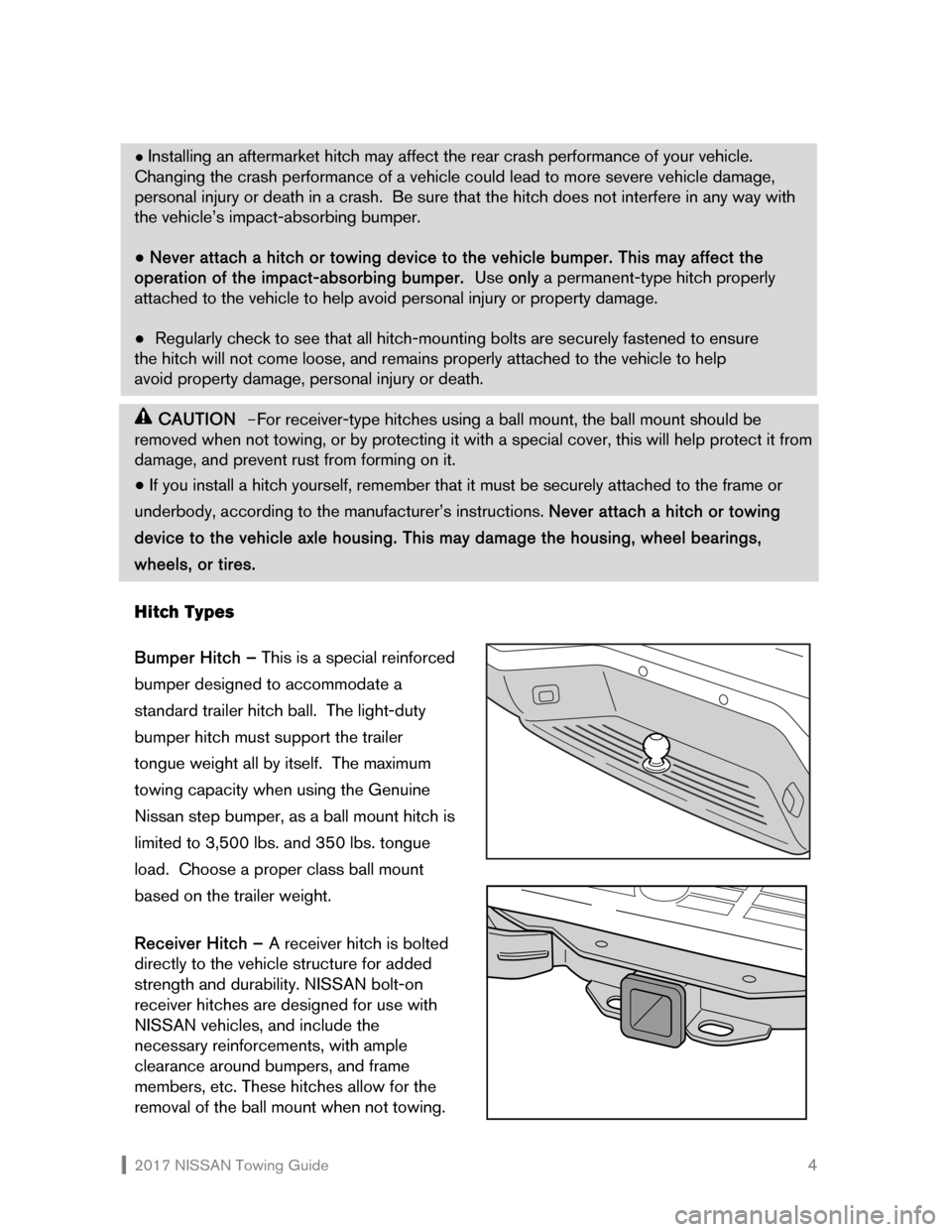
2017 NISSAN Towing Guide 4
● Installing an aftermarket hitch may affect the rear crash performance of your vehicle.
Changing the crash performance of a vehicle could lead to more severe vehicle damage,
personal injury or death in a crash. Be sure that the hitch does not interfere in any way with
the vehicle’s impact-absorbing bumper.
● Never attach a hitch or towing device to the vehicle bumper. This may affect the
operation of the impact-absorbing bumper. Use only a permanent-type hitch properly
attached to the vehicle to help avoid personal injury or property damage.
● Regularly check to see that all hitch-mounting bolts are securely fastened to ensure
the hitch will not come loose, and remains properly attached to the vehicle to help
avoid property damage, personal injury or death.
CAUTION -For receiver-type hitches using a ball mount, the ball mount should be
removed when not towing, or by protecting it with a special cover, this will help protect it from
damage, and prevent rust from forming on it.
● If you install a hitch yourself, remember that it must be securely attached to the frame or
underbody, according to the manufacturer’s instructions. Never attach a hitch or towing
device to the vehicle axle housing. This may damage the housing, wheel bearings,
wheels, or tires.
Hitch Types
Bumper Hitch – This is a special reinforced
bumper designed to accommodate a
standard trailer hitch ball. The light-duty
bumper hitch must support the trailer
tongue weight all by itself. The maximum
towing capacity when using the Genuine
Nissan step bumper, as a ball mount hitch is
limited to 3,500 lbs. and 350 lbs. tongue
load. Choose a proper class ball mount
based on the trailer weight.
Receiver Hitch – A receiver hitch is bolted
directly to the vehicle structure for added
strength and durability. NISSAN bolt-on
receiver hitches are designed for use with
NISSAN vehicles, and include the
necessary reinforcements, with ample
clearance around bumpers, and frame
members, etc. These hitches allow for the
removal of the ball mount when not towing.
Page 7 of 27
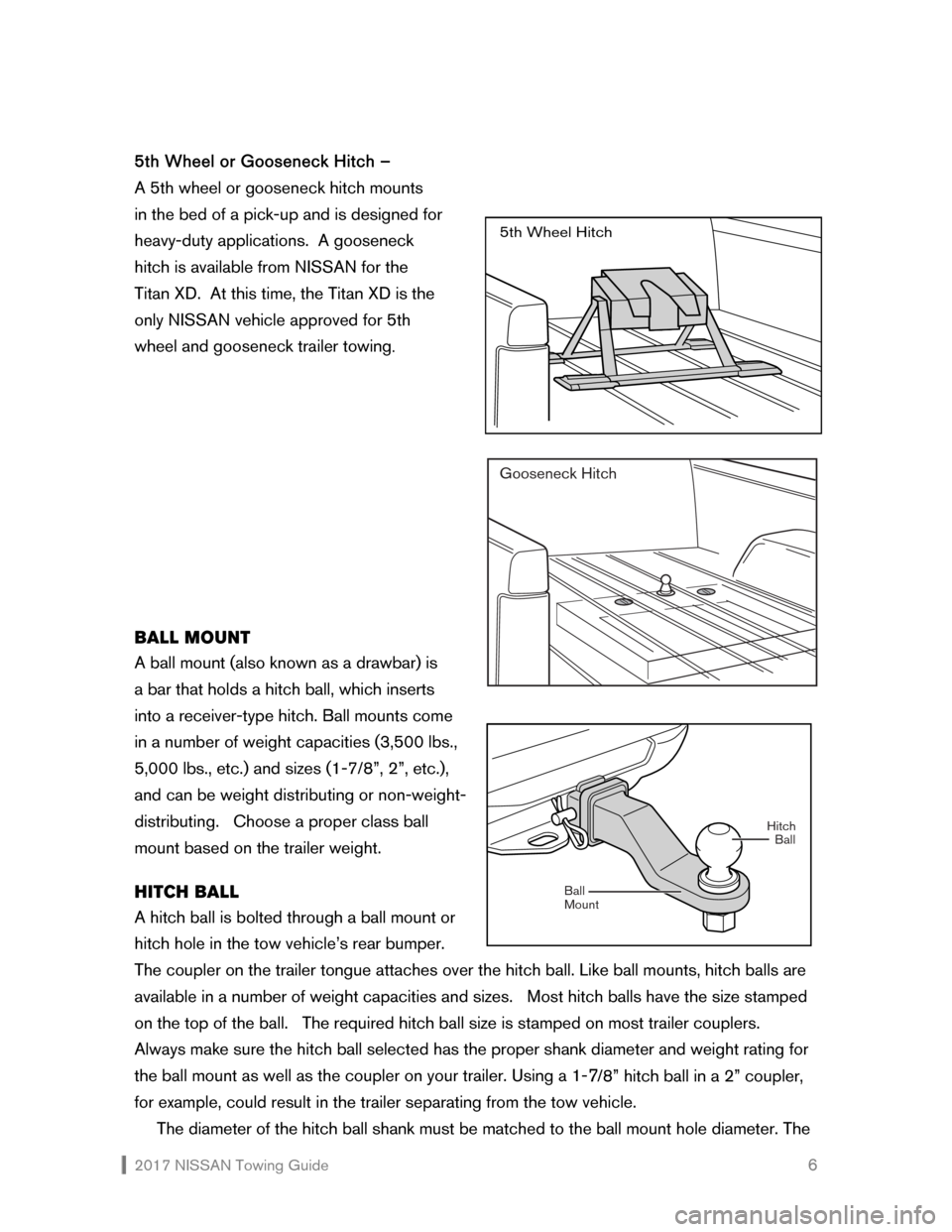
2017 NISSAN Towing Guide 6 5th Wheel or Gooseneck Hitch –
A 5th wheel or gooseneck hitch mounts
in the bed of a pick-up and is designed for
heavy-duty applications. A gooseneck
hitch is available from NISSAN for the
Titan XD. At this time, the Titan XD is the
only NISSAN vehicle approved for 5th
wheel and gooseneck trailer towing
.
BALL MOUNT
A ball mount (also known as a drawbar) is
a bar that holds a hitch ball, which inserts
into a receiver-type hitch. Ball mounts come
in a number of weight capacities (3,500 lbs.,
5,000 lbs., etc.) and sizes (1-7/8”, 2”, etc.),
and can be weight distributing or non-weight-
distributing. Choose a proper class ball
mount based on the trailer weight.
HITCH BALL
A hitch ball is bolted through a ball mount or
hitch hole in the tow vehicle’s rear bumper.
The coupler on the trailer tongue attaches over the hitch ball. Like ball mounts, hitch balls are
available in a number of weight capacities and sizes. Most hitch balls have the size stamped
on the top of the ball. The required hitch ball size is stamped on most trailer couplers.
Always make sure the hitch ball selected has the proper shank diameter and weight rating for
the ball mount as well as the coupler on your trailer. Using a 1-
7/8” hitch ball in a 2” coupler,
for example, could result in the trailer separating from the tow vehicle.
The diameter of the hitch ball shank must be matched to the ball mount hole diameter. The
5th Wheel Hitch
Gooseneck Hitch
Hitch
Mount BallBall
Page 8 of 27
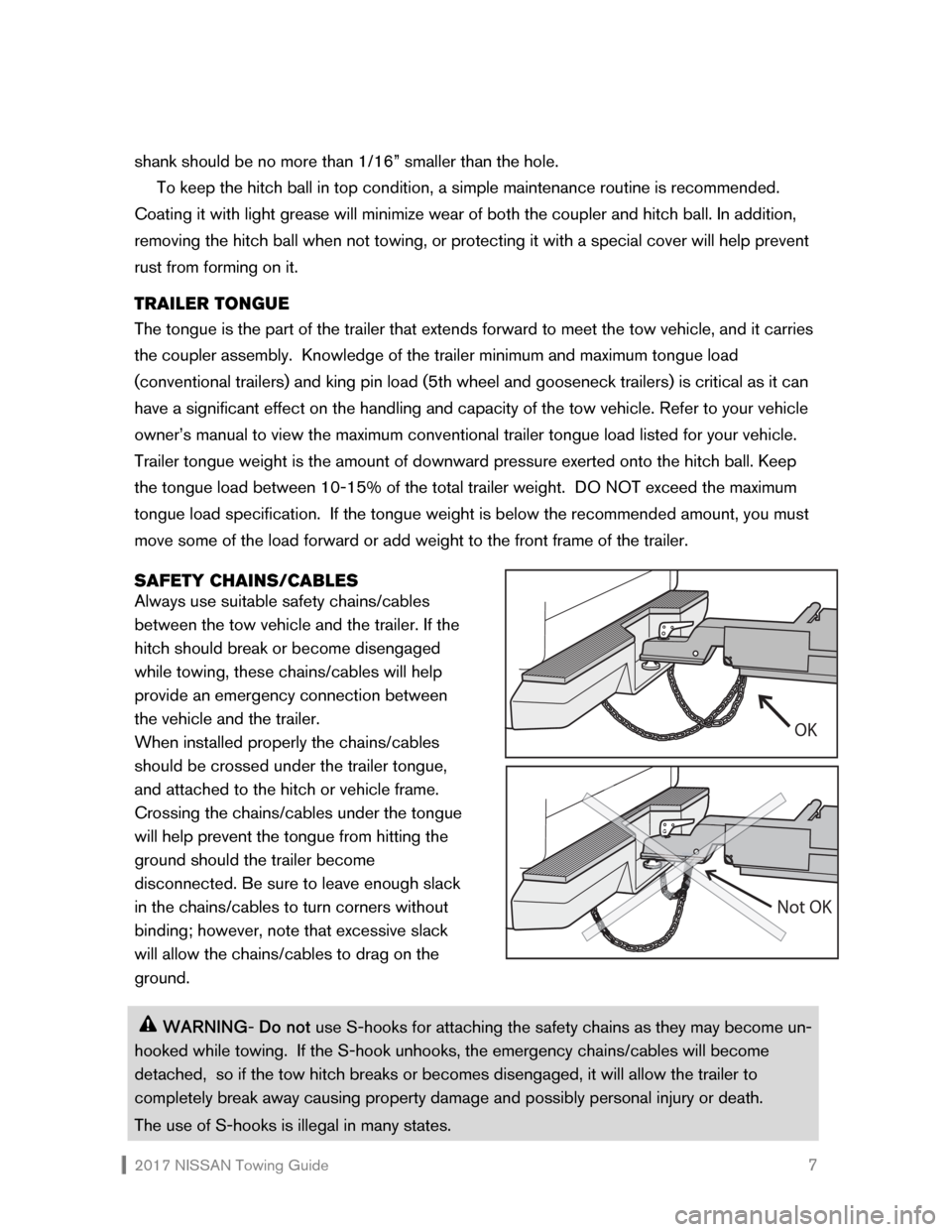
2017 NISSAN Towing Guide 7
shank should be no more than 1/16” smaller than the hole.
To keep the hitch ball in top condition, a simple maintenance routine is recommended.
Coating it with light grease will minimize wear of both the coupler and hitch ball. In addition,
removing the hitch ball when not towing, or protecting it with a special cover will help prevent
rust from forming on it.
TRAILER TONGUE
The tongue is the part of the trailer that extends forward to meet the tow vehicle, and it carries
the coupler assembly. Knowledge of the trailer minimum and maximum tongue load
(conventional trailers) and king pin load (5th wheel and gooseneck trailers) is critical as it can
have a significant effect on the handling and capacity of the tow vehicle. Refer to your vehicle
owner’s manual to view the maximum conventional trailer tongue load listed for your vehicle.
Trailer tongue weight is the amount of downward pressure exerted onto the hitch ball. Keep
the tongue load between 10-15% of the total trailer weight. DO NOT exceed the maximum
tongue load specification. If the tongue weight is below the recommended amount, you must
move some of the load forward or add weight to the front frame of the trailer.
SAFETY CHAINS/CABLES
Always use suitable safety chains/cables
between the tow vehicle and the trailer. If the
hitch should break or become disengaged
while towing, these chains/cables will help
provide an emergency connection between
the vehicle and the trailer.
When installed properly the chains/cables
should be crossed under the trailer tongue,
and attached to the hitch or vehicle frame.
Crossing the chains/cables under the tongue
will help prevent the tongue from hitting the
ground should the trailer become
disconnected. Be sure to leave enough slack
in the chains/cables to turn corners without
binding; however, note that excessive slack
will allow the chains/cables to drag on the
ground.
WARNING- Do not use S-hooks for attaching the safety chains as they may become un-
hooked while towing. If the S-hook unhooks, the emergency chains/cables will become
detached, so if the tow hitch breaks or becomes disengaged, it will allow the trailer to
completely break away causing property damage and possibly personal injury or death.
The use of S-hooks is illegal in many states.
OK
Not OK
Page 10 of 27
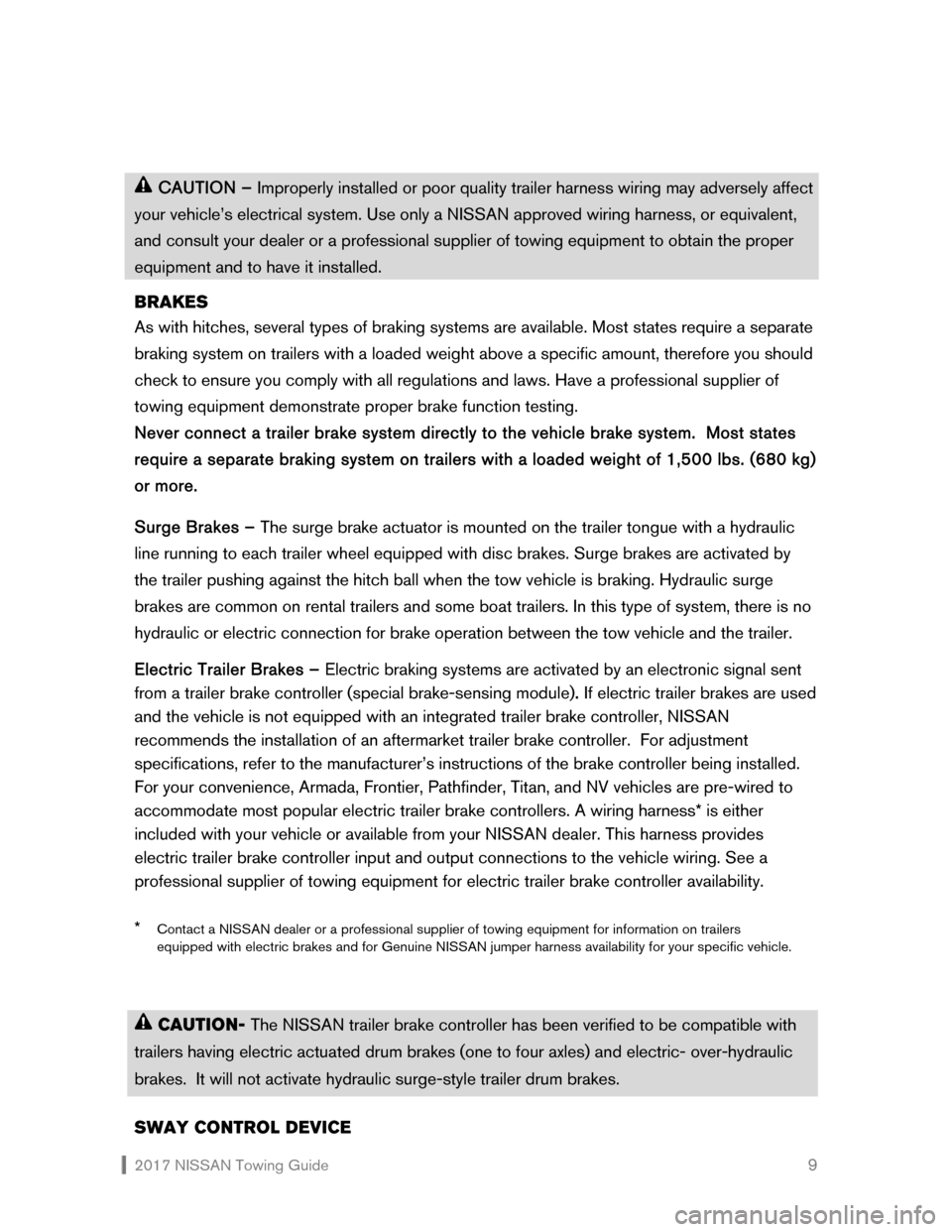
2017 NISSAN Towing Guide 9
CAUTION – Improperly installed or poor quality trailer harness wiring may adversely affect
your vehicle’s electrical system. Use only a NISSAN approved wiring harness, or equivalent,
and consult your dealer or a professional supplier of towing equipment to obtain the proper
equipment and to have it installed.
BRAKES
As with hitches, several types of braking systems are available. Most states require a separate
braking system on trailers with a loaded weight above a specific amount, therefore you should
check to ensure you comply with all regulations and laws. Have a professional supplier of
towing equipment demonstrate proper brake function testing.
Never connect a trailer brake system directly to the vehicle brake system. Most states
require a separate braking system on trailers with a loaded weight of 1,500 lbs. (680 kg)
or more.
Surge Brakes – The surge brake actuator is mounted on the trailer tongue with a hydraulic
line running to each trailer wheel equipped with disc brakes. Surge brakes are activated by
the trailer pushing against the hitch ball when the tow vehicle is braking. Hydraulic surge
brakes are common on rental trailers and some boat trailers. In this type of system, there is no
hydraulic or electric connection for brake operation between the tow vehicle and the trailer.
Electric Trailer Brakes – Electric braking systems are activated by an electronic signal sent
from a trailer brake controller (special brake-sensing module). If electric trailer brakes are used
and the vehicle is not equipped with an integrated trailer brake controller, NISSAN
recommends the installation of an aftermarket trailer brake controller. For adjustment
specifications, refer to the manufacturer’s instructions of the brake controller being installed.
For your convenience, Armada, Frontier, Pathfinder, Titan, and NV vehicles are pre-wired to
accommodate most popular electric trailer brake controllers. A wiring harness* is either
included with your vehicle or available from your NISSAN dealer. This harness provides
electric trailer brake controller input and output connections to the vehicle wiring. See a
professional supplier of towing equipment for electric trailer brake controller availability.
*
Contact a NISSAN dealer or a professional supplier of towing equipment for information on trailers
equipped with electric brakes and for Genuine NISSAN jumper harness availability for your specific vehicle.
CAUTION- The NISSAN trailer brake controller has been verified to be compatible with
trailers having electric actuated drum brakes (one to four axles) and electric- over-hydraulic
brakes. It will not activate hydraulic surge-style trailer drum brakes.
SWAY CONTROL DEVICE
Page 13 of 27
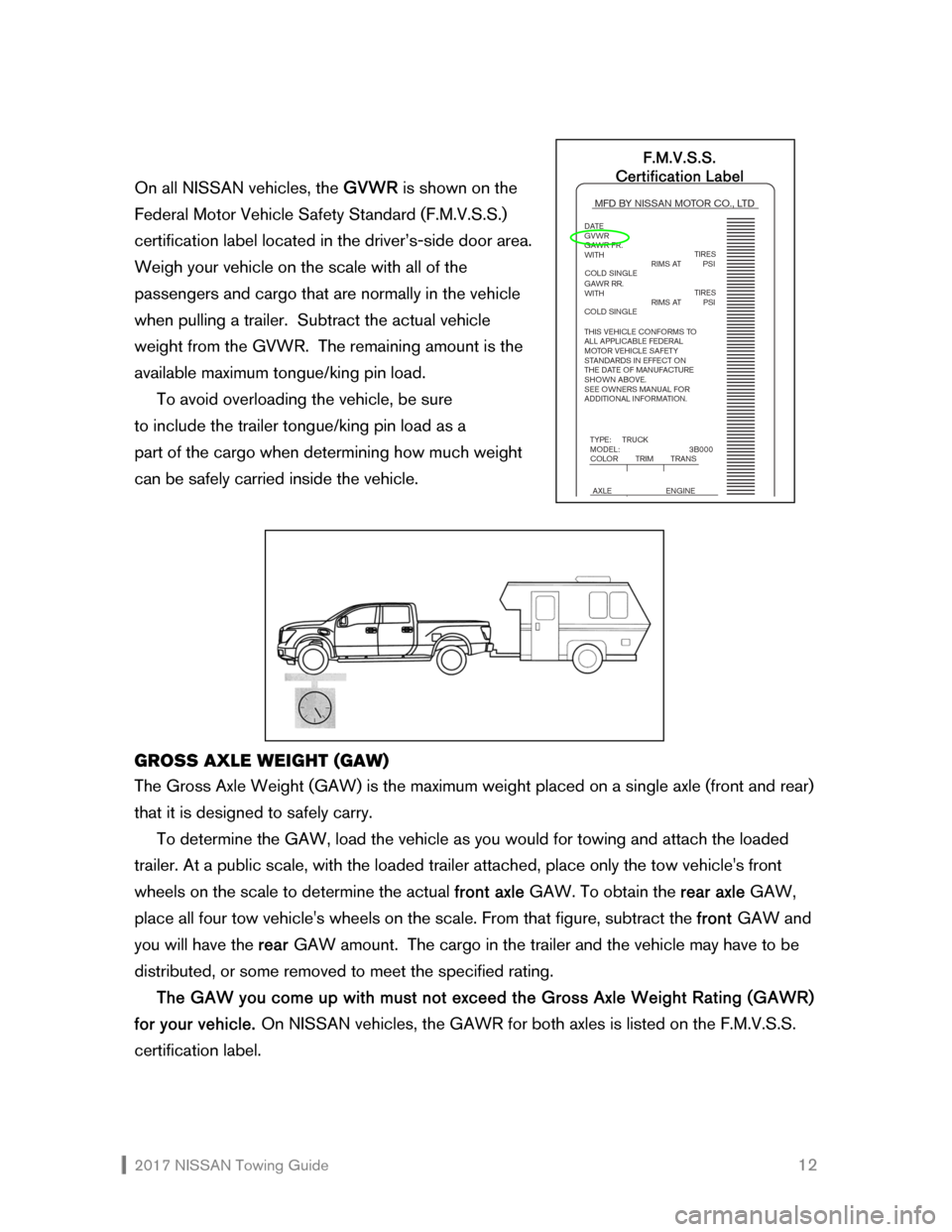
2017 NISSAN Towing Guide 12
On all NISSAN vehicles, the GVWR is shown on the
Federal Motor Vehicle Safety Standard (F.M.V.S.S.)
certification label located in the driver’s-side door area.
Weigh your vehicle on the scale with all of the
passengers and cargo that are normally in the vehicle
when pulling a trailer. Subtract the actual vehicle
weight from the GVWR. The remaining amount is the
available maximum tongue/king pin load.
To avoid overloading the vehicle, be sure
to include the trailer tongue/king pin load as a
part of the cargo when determining how much weight
can be safely carried inside the vehicle.
GROSS AXLE WEIGHT (GAW)
The Gross Axle Weight (GAW) is the maximum weight placed on a single axle (front and rear)
that it is designed to safely carry.
To determine the GAW, load the vehicle as you would for towing and attach the loaded
trailer. At a public scale, with the loaded trailer attached, place only the tow vehicle's front
wheels on the scale to determine the actual front axle GAW. To obtain the rear axle GAW,
place all four tow vehicle's wheels on the scale. From that figure, subtract the front GAW and
you will have the rear GAW amount. The cargo in the trailer and the vehicle may have to be
distributed, or some removed to meet the specified rating.
The GAW you come up with must not exceed the Gross Axle Weight Rating (GAWR)
for your vehicle. On NISSAN vehicles, the GAWR for both axles is listed on the F.M.V.S.S.
certification label.
MFD BY NISSAN MOTOR CO., LTD
DATE
GVWR
GAWR FR.
WITH
GAWR RR.
WITH
THIS VEHICLE CONFORMS TO
ALL APPLICABLE FEDERAL
MOTOR VEHICLE SAFETY
STANDARDS IN EFFECT ON
THE DATE OF MANUFACTURE
SHOWN ABOVE.
SEE OWNERS MANUAL FOR
ADDITIONAL INFORMATION.
TIRES
TIRES
TYPE: TRUCK
MODEL: 3B000
COLOR TRIM TRANS
AXLE ENGINE
RIMS AT PSI
COLD SINGLERIMS AT PSI
COLD SINGLE
F.M.V.S.S.
Certification Label
Page 14 of 27
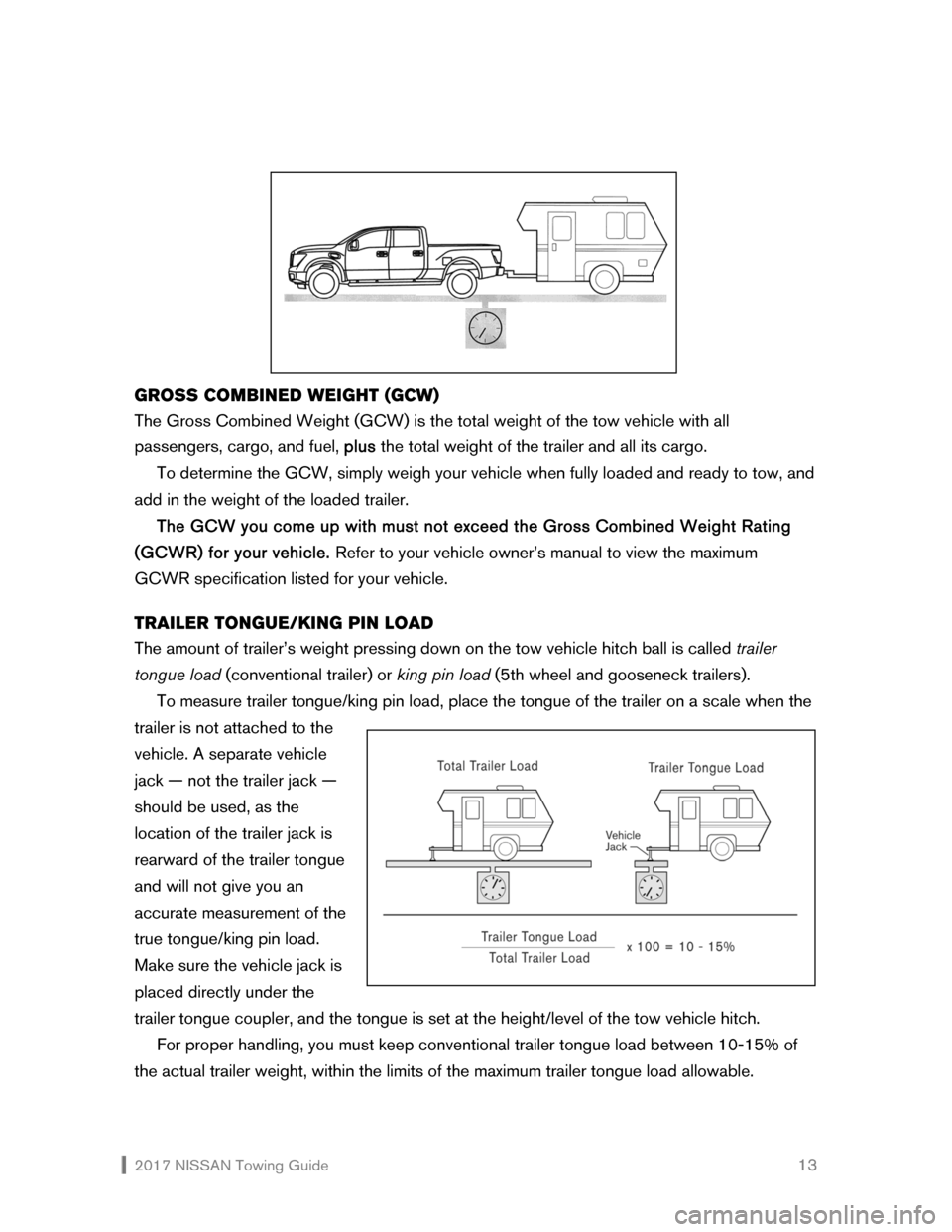
2017 NISSAN Towing Guide 13
GROSS COMBINED WEIGHT (GCW)
The Gross Combined Weight (GCW) is the total weight of the tow vehicle with all
passengers, cargo, and fuel, plus the total weight of the trailer and all its cargo.
To determine the GCW, simply weigh your vehicle when fully loaded and ready to tow, and
add in the weight of the loaded trailer.
The GCW you come up with must not exceed the Gross Combined Weight Rating
(GCWR) for your vehicle. Refer to your vehicle owner’s manual to view the maximum
GCWR specification listed for your vehicle.
TRAILER TONGUE/KING PIN LOAD
The amount of trailer’s weight pressing down on the tow vehicle hitch ball is called trailer
tongue load (conventional trailer) or king pin load (5th wheel and gooseneck trailers).
To measure trailer tongue/king pin load, place the tongue of the trailer on a scale when the
trailer is not attached to the
vehicle. A separate vehicle
jack — not the trailer jack —
should be used, as the
location of the trailer jack is
rearward of the trailer tongue
and will not give you an
accurate measurement of the
true tongue/king pin load.
Make sure the vehicle jack is
placed directly under the
trailer tongue coupler, and the tongue is set at the height/level of the tow vehicle hitch.
For proper handling, you must keep conventional trailer tongue load between 10-15% of
the actual trailer weight, within the limits of the maximum trailer tongue load allowable.
Page 15 of 27
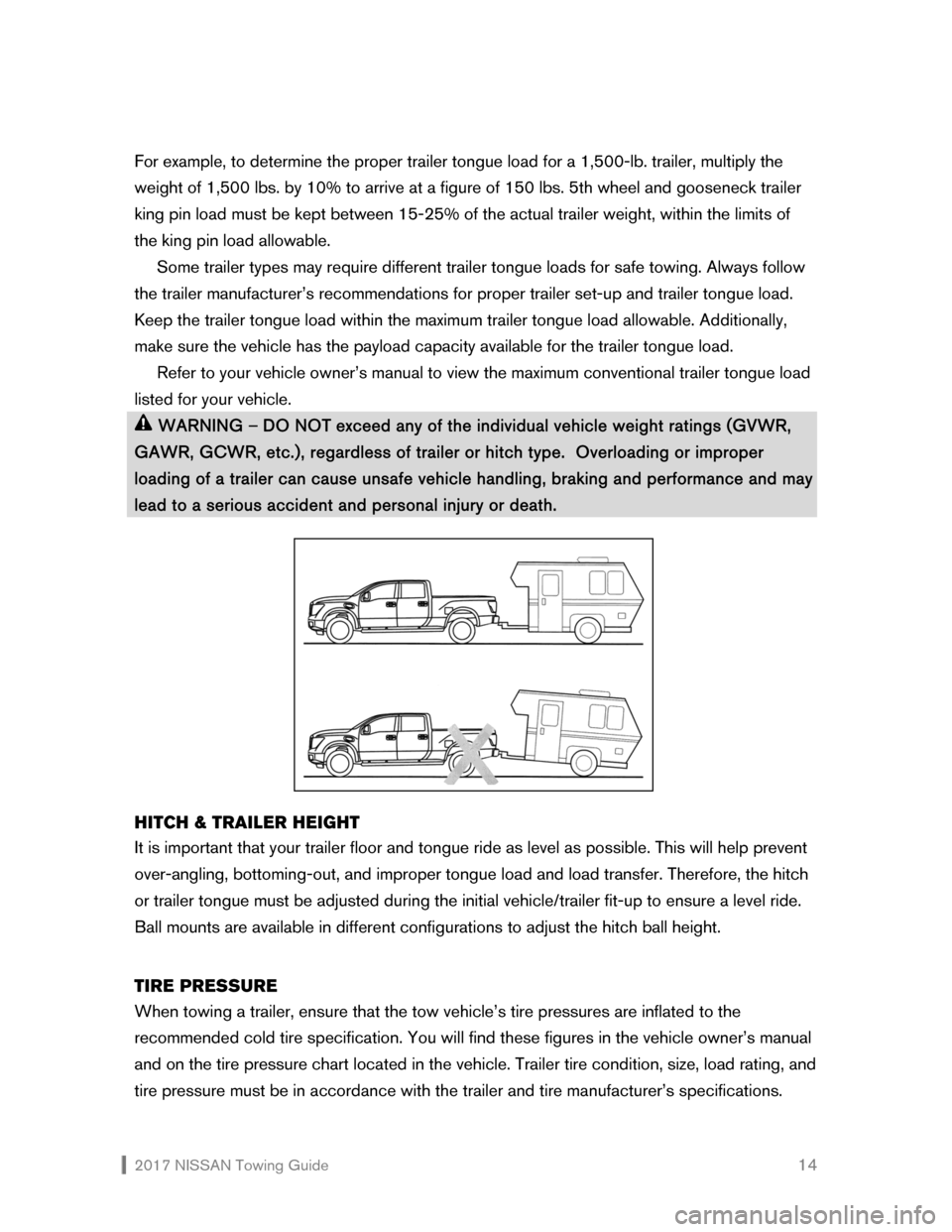
2017 NISSAN Towing Guide 14
For example, to determine the proper trailer tongue load for a 1,500-lb. trailer, multiply the
weight of 1,500 lbs. by 10% to arrive at a figure of 150 lbs. 5th wheel and gooseneck trailer
king pin load must be kept between 15-25% of the actual trailer weight, within the limits of
the king pin load allowable.
Some trailer types may require different trailer tongue loads for safe towing. Always follow
the trailer manufacturer’s recommendations for proper trailer set-up and trailer tongue load.
Keep the trailer tongue load within the maximum trailer tongue load allowable. Additionally,
make sure the vehicle has the payload capacity available for the trailer tongue load.
Refer to your vehicle owner’s manual to view the maximum conventional trailer tongue load
listed for your vehicle.
WARNING – DO NOT exceed any of the individual vehicle weight ratings (GVWR,
GAWR, GCWR, etc.), regardless of trailer or hitch type. Overloading or improper
loading of a trailer can cause unsafe vehicle handling, braking and performance and may
lead to a serious accident and personal injury or death.
HITCH & TRAILER HEIGHT
It is important that your trailer floor and tongue ride as level as possible. This will help prevent
over-angling, bottoming-out, and improper tongue load and load transfer. Therefore, the hitch
or trailer tongue must be adjusted during the initial vehicle/trailer fit-up to ensure a level ride.
Ball mounts are available in different configurations to adjust the hitch ball height.
TIRE PRESSURE
When towing a trailer, ensure that the tow vehicle’s tire pressures are inflated to the
recommended cold tire specification. You will find these figures in the vehicle owner’s manual
and on the tire pressure chart located in the vehicle. Trailer tire condition, size, load rating, and
tire pressure must be in accordance with the trailer and tire manufacturer’s specifications.
Page 16 of 27
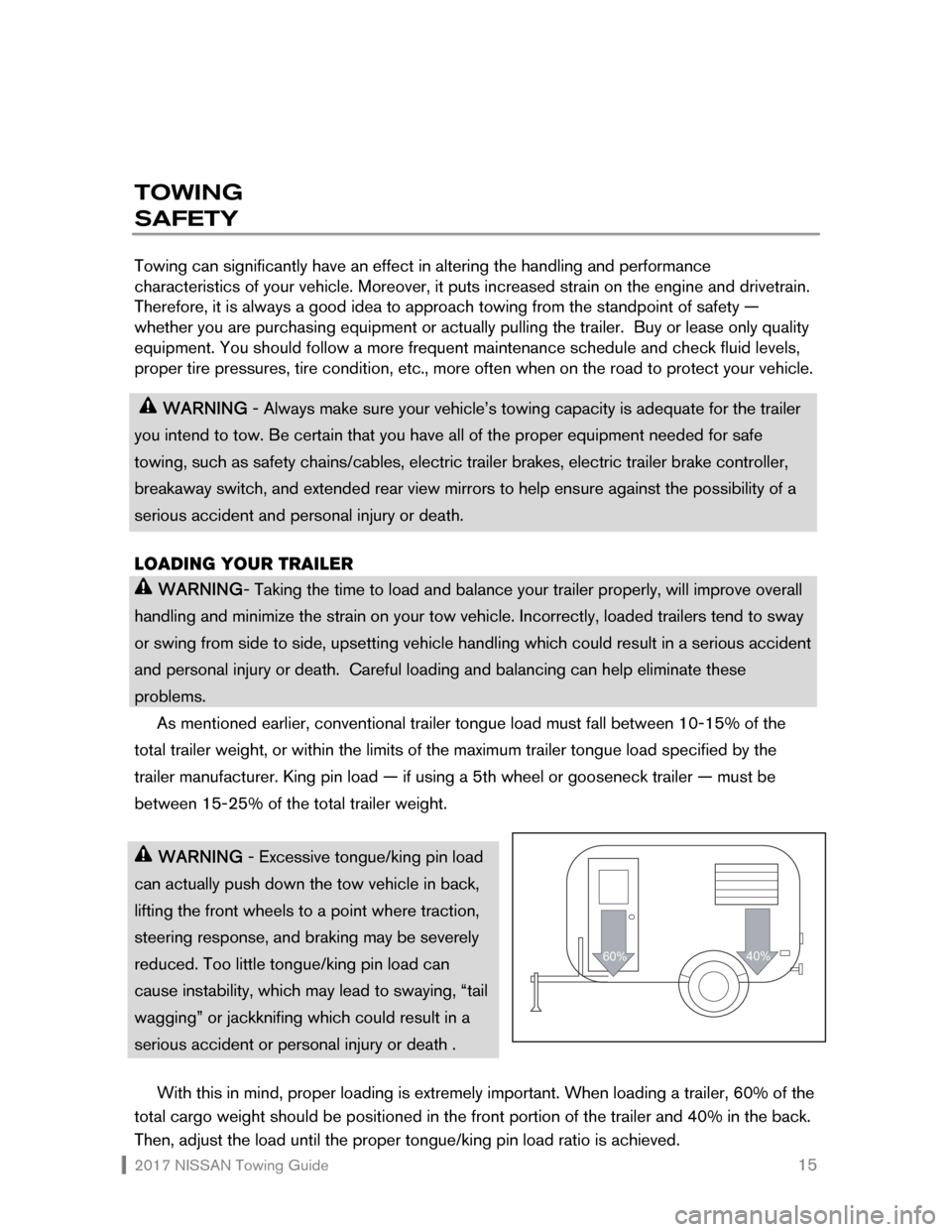
2017 NISSAN Towing Guide 15
TOWING
SAFETY
Towing can significantly have an effect in altering the handling and performance
characteristics of your vehicle. Moreover, it puts increased strain on the engine and drivetrain.
Therefore, it is always a good idea to approach towing from the standpoint of safety —
whether you are purchasing equipment or actually pulling the trailer. Buy or lease only quality
equipment. You should follow a more frequent maintenance schedule and check fluid levels,
proper tire pressures, tire condition, etc., more often when on the road to protect your vehicle.
WARNING - Always make sure your vehicle’s towing capacity is adequate for the trailer
you intend to tow. Be certain that you have all of the proper equipment needed for safe
towing, such as safety chains/cables, electric trailer brakes, electric trailer brake controller,
breakaway switch, and extended rear view mirrors to help ensure against the possibility of a
serious accident and personal injury or death.
LOADING YOUR TRAILER
WARNING- Taking the time to load and balance your trailer properly, will improve overall
handling and minimize the strain on your tow vehicle. Incorrectly, loaded trailers tend to sway
or swing from side to side, upsetting vehicle handling which could result in a serious accident
and personal injury or death. Careful loading and balancing can help eliminate these
problems.
As mentioned earlier, conventional trailer tongue load must fall between 10-15% of the
total trailer weight, or within the limits of the maximum trailer tongue load specified by the
trailer manufacturer. King pin load — if using a 5th wheel or gooseneck trailer — must be
between 15-25% of the total trailer weight.
WARNING - Excessive tongue/king pin load
can actually push down the tow vehicle in back,
lifting the front wheels to a point where traction,
steering response, and braking may be severely
reduced. Too little tongue/king pin load can
cause instability, which may lead to swaying, “tail
wagging” or jackknifing which could result in a
serious accident or personal injury or death .
With this in mind, proper loading is extremely important. When loading a trailer, 60% of the
total cargo weight should be positioned in the front portion of the trailer and 40% in the back.
Then, adjust the load until the proper tongue/king pin load ratio is achieved.
60%40%